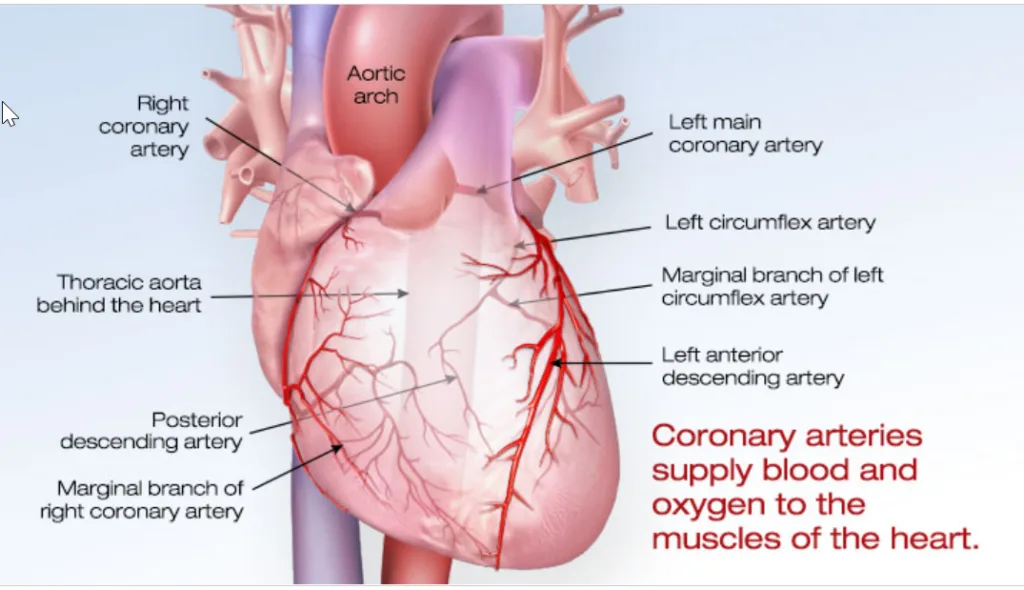Introduction: What is a Heart Attack?
A heart attack, also known as a myocardial infarction (MI), is a life-threatening medical emergency that occurs when the blood flow to the heart muscle is suddenly blocked. This blockage deprives the heart muscle of oxygen, leading to tissue damage or death if not treated promptly. Although heart attacks are often associated with severe chest pain, the symptoms and severity can vary greatly from person to person.
In this blog post, we’ll explore the causes, symptoms, and treatment of heart attacks, as well as how to lower your risk of experiencing one.

What Causes a Heart Attack?
The primary cause of a heart attack is the narrowing or blockage of the coronary arteries. These arteries supply oxygen-rich blood to the heart muscle. The most common reason for this blockage is atherosclerosis, a slow buildup of fatty deposits (plaque) inside the artery walls. Over time, the plaque can harden or rupture, causing a blood clot that obstructs the blood flow to the heart.
View an animation of blood flow between the heart and lungs.
Other potential causes of a heart attack include:
- Coronary Artery Spasm: A temporary tightening or spasm of the coronary arteries can reduce blood flow to the heart, leading to a heart attack. This type of heart attack can occur even without the presence of plaque buildup.
- Spontaneous Coronary Artery Dissection (SCAD): SCAD is a rare condition in which a tear forms in one of the heart’s arteries, leading to a blockage. SCAD primarily affects younger, healthy individuals and is different from typical heart attacks caused by plaque buildup.
Common Symptoms of a Heart Attack
Recognizing the symptoms of a heart attack is critical to seeking immediate treatment. Although chest pain is the hallmark symptom, heart attacks may present differently, especially in women.
Common heart attack symptoms include:
- Chest discomfort, pressure, or pain that may spread to the arms, neck, jaw, or back
- Shortness of breath, with or without chest discomfort
- Nausea, vomiting, or indigestion
- Sweating or cold sweats
- Lightheadedness or dizziness
- Fatigue or weakness
Silent Heart Attacks
In some cases, individuals experience a “silent heart attack,” where symptoms are mild or even unnoticed. Silent heart attacks are just as dangerous as their symptomatic counterparts, making regular health checkups and monitoring crucial for those at risk.
Heart Attack vs. Cardiac Arrest
It is important to distinguish between a heart attack and sudden cardiac arrest (SCA). A heart attack is a blockage in blood flow to the heart, while cardiac arrest is when the heart suddenly stops beating due to an electrical malfunction. A heart attack can sometimes trigger cardiac arrest, but the two conditions are not the same.
Key Differences:
- Heart Attack: A circulation problem caused by blocked arteries, where the heart muscle is deprived of oxygen.
- Cardiac Arrest: An electrical problem where the heart malfunctions and stops beating.
Risk Factors for a Heart Attack
Certain risk factors increase your likelihood of experiencing a heart attack. Some are controllable, while others, like family history or age, are not. However, lifestyle changes can significantly reduce the risk.
Controllable Risk Factors:
- High blood pressure
- High cholesterol levels
- Smoking
- Obesity
- Physical inactivity
- Unhealthy diet
- Excessive alcohol consumption
- Stress
Uncontrollable Risk Factors:
- Age: Men aged 45 and older and women aged 55 and older are at greater risk.
- Family history of heart disease
- Pre-existing conditions like diabetes or coronary artery disease (CAD)
Treatment and Recovery After a Heart Attack
The quicker you receive treatment during a heart attack, the better your chances of minimizing heart damage. Treatments range from medication to restore blood flow, such as clot-busting drugs or blood thinners, to more invasive procedures like angioplasty or bypass surgery.
Once treated, recovery begins, but the extent and duration of recovery depend on the severity of the heart attack and how quickly it was treated.
Lifestyle Changes for Recovery and Prevention
After surviving a heart attack, many people can go on to lead productive, fulfilling lives with the right changes. It’s essential to work closely with healthcare professionals to create a recovery plan tailored to your needs.
Key components of heart attack recovery include:
- Medication: Many heart attack survivors are prescribed medications to manage blood pressure, cholesterol levels, or reduce the risk of blood clots.
- Cardiac Rehabilitation: This medically supervised program is designed to improve heart health through exercise, education, and counseling. It’s highly recommended for heart attack survivors to prevent future incidents.
- Lifestyle Changes: Adopting a heart-healthy lifestyle is crucial for preventing another heart attack. This includes eating a balanced diet rich in fruits, vegetables, lean proteins, and whole grains while avoiding processed foods high in sugar, salt, and unhealthy fats.
- Physical Activity: Regular exercise is vital for cardiovascular health. Depending on your recovery stage, your doctor may recommend light to moderate exercise, such as walking, cycling, or swimming.
- Quitting Smoking: Smoking is a major risk factor for heart disease, so quitting is essential to improving your overall heart health.
Conclusion: Managing Heart Health After a Heart Attack
A heart attack can be a life-altering event, but with proper treatment, lifestyle changes, and support, it’s possible to recover and reduce the risk of future heart problems. Awareness and education about heart attack symptoms, causes, and prevention are key to taking control of your heart health.
If you or someone you know is at risk of heart disease, take proactive steps to improve cardiovascular health by managing risk factors, staying active, and maintaining regular checkups with your healthcare provider.
Remember, a heart attack doesn’t have to define your life—take action now to lead a healthier, longer life.
